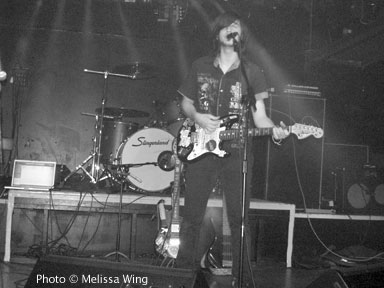Remember Apple's old catch phrase, Think Different? It's
definitely my favorite slogan of all time. When I think of Mac users, I
think different. We're all different, and yet we use Macs to do what we
do best.
I recently had the pleasure of interviewing a group of people who
use Macs for their extraordinary work. I picked their brains about what
their workflow is like, what their favorite applications are, and what
their dream machines are.

Max Miller with his MacBook Pro (on the left).
Phil Herlihy: Who are you, and what do you do?
Max Miller: My name is Max Miller, and I'm a solo alternative
musician from New York.
Phil: How'd you get started as a musician?
Max: In 3rd grade, I started playing double bass in the
orchestra, and about a year later everything changed. I was riding in
the car with my parents when I heard the loud screams of Kurt Cobain
over the radio. I had never heard anything like this before and
instantly wanted to know more. I picked up electric bass from there. In
the 7th grade, I met the singer of Powerman 5000, Spider One, and got
his autograph. I realized how happy the signature made me, and that I
wanted to be able to make people happy like that.
Phil: What made you start using a Mac?
Max: I went to this movie camp that had all Macs. I saw how
it was easier to use and liked it a lot better than my PC.
Phil: Which was your first Mac?
Max: My first Mac was a "Digital Audio" G4 tower.
Originally, it had OS 9. Eventually, I upgraded it to OS X.
At first, it was odd to use OS X, because I didn't know much about
Macs, having used a PC most of my life.
Phil: How was the transition from your PC to your new
Mac?
Max: It was quick. I already had a basic idea of how to use
it from the camp and quickly made it a point to learn the hotkeys and
shortcuts. It was just much easier than PC. Everything was easy.
Phil: When did you get your first Mac?
Max: That was in 2004.
Phil: Did you have a favorite application?
Max: It was iPiano, which was a very poorly made version of
"Musical Typing" in GarageBand. There was no real way to keep time or
to quantize the beats. But I liked it because it had a huge variety of
instruments and sounds to play with.
Phil: What Mac do you use now?
Max: 15" MacBook Pro from
2006.
Phil: Do you have any other Apple products?
Max: I have an iPhone 3G.
Phil: Do you prefer Macs to PCs?
Max: Absolutely.
Phil: Why?
Max: The user interface is much more user friendly. It
crashes less frequently, and it can run Windows anyway.
Phil: How have Macs helped you in your music?
Max: Well, I recorded my entire first album completely using
iPiano for beats and GarageBand for all layers of vocals and
instruments. And I released that album to the
iTunes Music Store, which was a good way to spread the word about
it. Since then, I've started to use other applications like iDrum,
ProTools, Ableton Live! as well as using BootCamp for PC-only programs
like Fruity Loops.
In the live setting, I'll use either my MacBook Pro or my iPhone to
play background beats and bass lines through the sound system to bring
a full band sound to my solo stage act.
I use an app on my iPhone called GuitarToolkit, which I use before
every show and recording, as a tuner. And I recently started using
another app called FourTrack, which acts as a fully-functioning four
track recorder for the iPhone.
Phil: Do you have a favorite feature of OS X?
Max: My favorite feature of OS X is Spotlight, because I
write a lot of lyrics on my computer, and sometimes they tend to get
lost over time. One day if I remember just one lyric, I can Spotlight
the entire song and pick it up again.
Phil: Is there one thing you'd change about your Mac, if you
could?
Max: Nothing really comes to mind. I've had it for three
years, and it works just as well as I need it to. And it has always
been able to do what I needed it to do.
Phil: How do you go about creating music on your Mac?
Max: Well, usually if I have a guitar riff in mind, I'll open
up iDrum and create a simple beat. Then I import that into ProTools and
then start adding the rest of layers of the song. Usually it'll start
with the bass line and then move up to the guitar track before finally
laying down the vocals.
After the basic parts are down, I'll start making random layers and
recording whatever comes to mind. I then save the stuff that I like and
delete the stuff that I don't.
Phil: Where can we check out your music, Max?
Max: You can go to MaxMillerMakesMusic.com to
learn more about me and download my new album for free! You can also
follow me on
Twitter.
Phil: Thanks for your time, Max.




